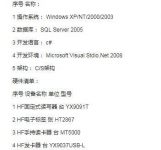
Application of RFID in medical disinfection
[ad_1]
introduction
In the medical industry in recent years, with the continuous improvement of hospital informatization and intelligent management construction and the continuous improvement of patients’ satisfaction with medical services, the hospital’s radio frequency identification (RFID) and hospital information (HIS) technologies have been continuously combined and improved. , Provide greater convenience for patients and hospitals. The RFID supply room equipment package traceability management system is to provide effective management guarantee for the hospital disinfection supply room. The RFID radio frequency identification technology supply room equipment package traceability management system is developed based on the current status of the hospital disinfection supply room management and its importance in the medical process. This system uses radio frequency identification (RFID), barcode technology and combined with network technology. Through the use of this system, the management of the disinfection supply room is scientific and clarified.
Including two aspects of industrialization key technology and application key technology. Among them, the key technology of RFID automatic identification industrialization mainly includes: RFID tag chip design and manufacturing: such as low-cost, low-power RFID chip design and manufacturing technology, suitable for tag chip implementation New storage technology, anti-collision algorithm and circuit implementation technology, chip security technology, and tag chip and sensor integration technology. Antenna design and manufacturing: such as RFID electronic tag antenna matching technology, RFID electronic tag antenna structure optimization technology for different application objects, multi-tag antenna optimization distribution technology, on-chip antenna technology, RFID reader smart beam scanning antenna array technology, and RFID Electronic tag antenna design simulation software, etc.
System implementation goals
From a management perspective:
This system realizes to strengthen personnel management, fully mobilize the enthusiasm of personnel, strengthen the sense of responsibility of the staff, clarify the scope of responsibility, and reduce the risk of medical accidents; this system manages, inquires, and counts the equipment packages in the disinfection supply room , Analysis, facilitates the configuration of the equipment package between the hospital departments, the inspection of the supervision department, and the leadership decision-making. Improve the hospital safety management mechanism. The problems are well documented, and the goal of informatization management of the entire process is finally realized.
From an economic perspective:
This system achieves cost control of the equipment package in the disinfection supply room by reusing RFID electronic tags. Through the use of this system, paperless office is provided and office costs are reduced. Through the use of this system, the equipment package configuration is more reasonable, avoiding repeated purchases, loss, etc., and ultimately achieving the goal of saving costs.
From the perspective of function expansion:
The system provides interfaces with HIS and other large-scale systems to realize data sharing across the hospital system. Ensure the scalability of the software, and reserve interfaces with other monitoring systems.
Software Environment:

System Features
In terms of coupling method (inductance-electromagnetic), communication process (FDX, HDX, SEQ), data transmission method from radio frequency card to reader (load modulation, backscatter, high-order harmonics), and frequency range, there are different There are fundamental differences in non-contact transmission methods, but all readers are very similar in functional principles and the resulting design and structure. All readers can be simplified into two basic modules, a high-frequency interface and a control unit.
The high-frequency interface includes a transmitter and a receiver, and its functions include:
(1) Generate high-frequency transmission power to activate the radio frequency card and provide energy; modulate the transmitted signal to transmit data to the radio frequency card; receive and demodulate the high-frequency signal from the radio frequency card.
(2) The record information of the equipment package is more accurate and comprehensive: each equipment package is encapsulated with an electronic label. The label contains data such as the type, quantity, and disinfection date of the equipment. These data can be read during the entire process. Data such as distribution, recycling, and cleaning can be supplemented at any time;
(3) Improve management efficiency and facilitate traceability: Relevant managers can easily understand the information of each link in the entire process of recycling, cleaning, packaging, sterilization, and distribution of equipment packages by reading the electronic tags, and can eliminate infection accidents. The responsible link and the responsible person are finally determined for the irresponsible link;
(4) Avoid the hidden danger of infection recorded on the traditional instrument package paper: as a traditional recording method, the record on the instrument package paper actually constitutes one of the sources of surgical infection. After the RFID management and traceability system is adopted, the recording paper will not be used to avoid The hidden danger of infection;
(5) Cost savings: The system records the relevant data of sterilization and disinfection, which saves a certain amount of time, and saves considerable costs because the sterilization test paper is no longer used. The use of high temperature resistant electronic tags: after 143 degrees of high temperature, 3 After the harsh environment of atmospheric pressure, the label can still work normally.
[ad_2]



